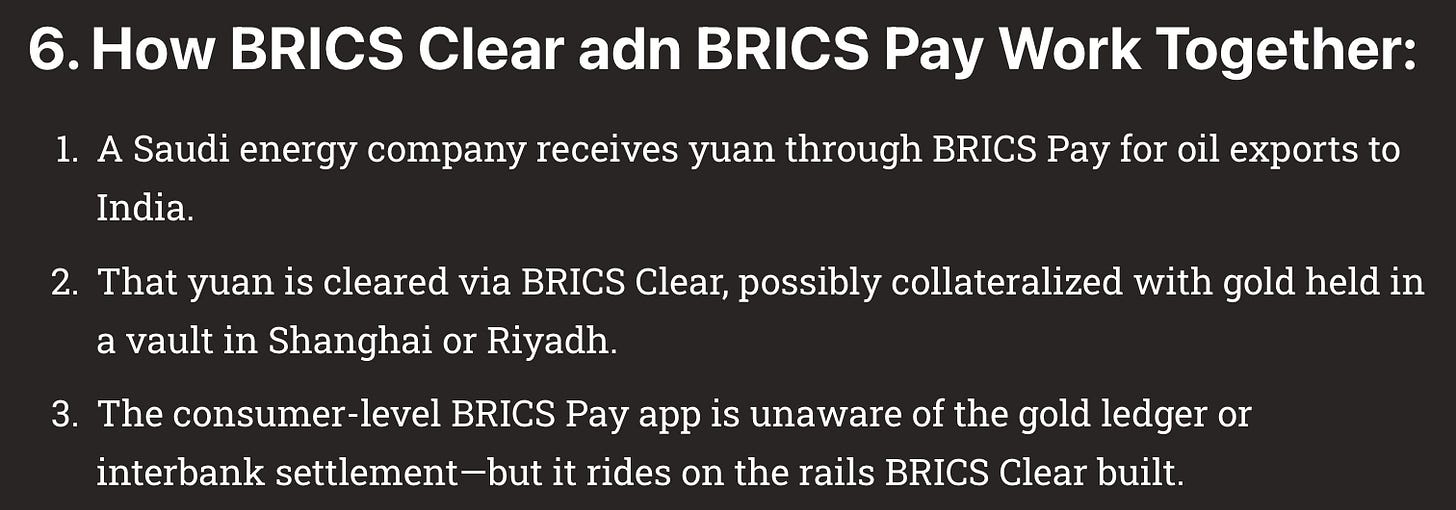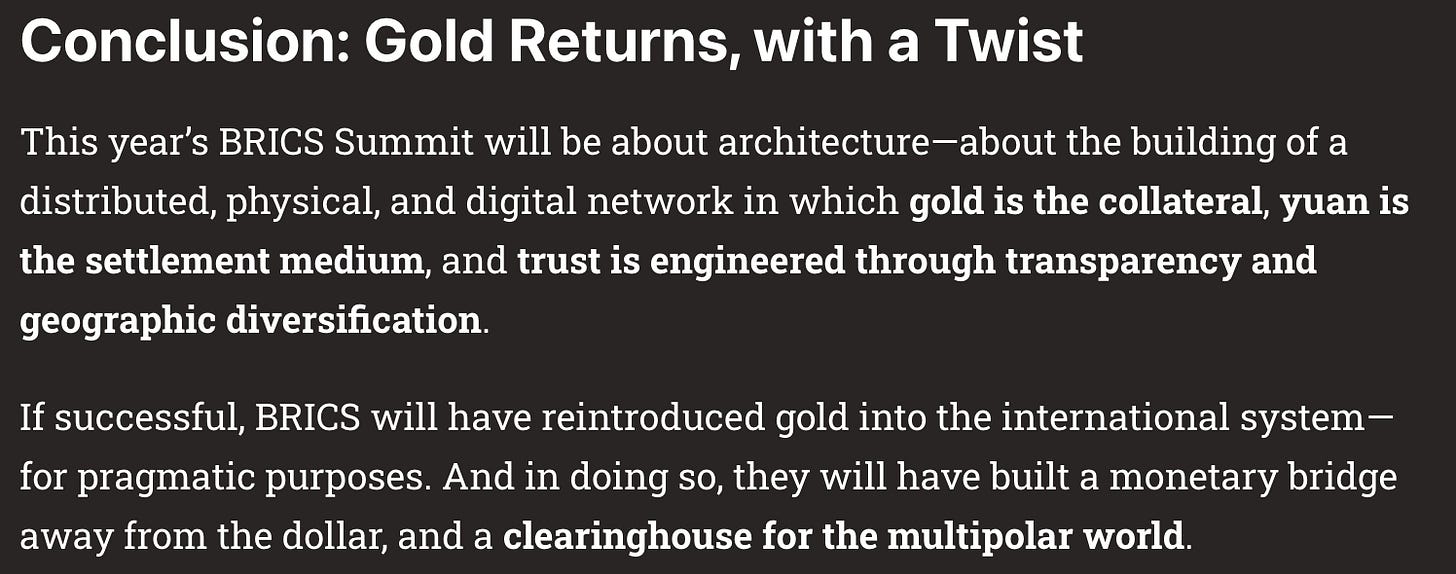It was a quiet, but positive day for the gold and silver pricing on Wednesday.
The gold futures are currently $20 higher.
While silver is up 2 cents versus yesterday.
Yet for today’s column, we’re going to look at this year's BRICS Summit, which is coming up in just over a month on July 6th.
And while there doesn’t seem to be as much attention around the 2025 Summit in the mainstream press as we saw last year, fortunately enough, my dear colleague Vince Lanci of Goldfix has been able to dig up the agenda that China wants to move forward.
So especially at this particular time, with the tariff war still far from resolved, a big hat tip to Vince, who wrote three great articles laying out what you can expect next month.
For a more thorough understanding of the agenda, I would highly recommend reading all three of his articles, which will be linked in this piece. Although if you just want the key bullets and highlights, that's what I will share here.
In his first piece titled ‘The BRICS 2025 De-dollarization Endgame,’ he starts by laying out the underlying premise that’s the end goal that the rest of the plans are based on
As the world’s financial architecture fractures along geopolitical lines, this year’s BRICS Summit appears poised to deliver a significant, if under-appreciated, evolution in global trade mechanics.
While headlines may focus on digital currencies, de-dollarization rhetoric, or commodity pricing shifts, the real development lies in something more physical, and far more consequential: the internationalization of gold as collateral.
Although BRICS summits often produce a flurry of narratives about multipolarity and economic self-determination, this year’s core financial innovation is rooted in the creation of a multi-jurisdictional gold custody network.
These vaults, currently under construction or negotiation in China, Saudi Arabia, Southeast Asia, and Africa, represent far more than logistical upgrades. They are the structural backbone of a new settlement system where gold is the primary collateral asset, replacing the U.S. Treasury bond as the standard bearer of trust.
In the legacy SWIFT system, Treasuries have played that role. Dollar-denominated bonds provided the liquidity, yield, and presumed security needed to lubricate global trade.
But now, for political and structural reasons, many nations—especially BRICS members—no longer view Treasuries as neutral or safe. The demand, therefore, is for a new currency and a new form of collateral: one that is apolitical, finite, and universally recognized.
Enter gold.
Vince writes about how ‘China has made no secret of its ambition to internationalize the yuan.’ Although also distinguishes between that statement, and the idea of China pushing for the Yuan as a reserve currency, which is a different proposition (and not what Vince is asserting).
The model is simple, but powerful: gold serves as the store of value, while the yuan functions as the medium of exchange. The two operate as complementary halves of a single monetary system.
Think of it like a razor-and-blade model: the yuan is the free razor distributed through trade agreements, while gold—held securely in regional vaults—functions as the valuable blade that makes for trust and thus repeated use.
Critically, the system is built on optionality. Participants are not required to convert yuan into gold, but they may do so. In effect, this introduces a convertibility layer into the yuan that mimics the gold window of Bretton Woods without forcing a formal gold standard.
It’s a model that offers flexibility for central banks, credibility for counterparties, and ballast for the currency itself.
He discusses the multi-country gold vault network that China has been part of organizing, and also how blockchain ledger technology will be used as part of the accounting measure.
The plan unveiled—implicitly and soon formally—by China involves the creation or certification of multiple gold vaults across the BRICS landscape.
Rather than centralizing gold in a single jurisdiction (as the U.S. does at Fort Knox or the NY Fed), this model emphasizes mutual hostage-taking. Each BRICS member places a portion of their gold in the vaults of other members. Your gold is in my country; mine is in yours. This prevents any one actor from dominating the system and provides a natural check on bad behavior.
As one analyst put it, “They’re not reinventing anything. They’re just resurrecting the only thing that ever worked.”
But beneath the surface, it represents the re-monetization of gold—not as currency, but as collateral guaranteeing currency validity. Gold isn’t replacing fiat currencies. It is replacing what guarantees them, specifically Treasuries.
Blockchain enables real-time auditing and verification of gold ownership across distributed vaults. mBridge enables interoperability between central banks, allowing them to settle claims backed by gold without needing to move the metal.
This solves both the trust problem and the speed problem. Gold remains stationary, but ownership can change instantly. It is “slow money” moving at “fast money” velocity. This changes everything.
How much of this will be formally announced at the Summit remains an open question.
Although here Vince leaves some clues to look for, as well as the language that might be used.
He also talked about another new part of the payment system that he expects we’ll start hearing more about, ‘BRICS Clear.’ which he describes by saying:
BRICS Clear is the infrastructure layer that enables settlement between currencies, often backed by gold or other collateral.
BRICS Pay rides on top of this infrastructure, allowing people and businesses to make payments in local currencies across borders.
‘BRICS Clear is the engine/backbone. BRICS Pay is the dashboard/user interface. They work together, but they are not the same thing at all.’
In terms of an actual example of how the new technology would be used, he explains the following:
So if you’ve just read all of that and you’re wondering, what’s the goal behind all of this, then here you go.
Now in case you’re still feeling a little overwhelmed by all of that, and not sure what to make out of it, I did talk about this on an episode of our YouTube show last week, which begins at the 5:30 mark of this video.
Fortunately Vince also leaves us with the following conclusion.
I’m sure we’ll be hearing plenty more in the month leading up to the summit, and as always, we’ll keep you posted here.
Sincerely,
Chris Marcus, with a special thank you to Vince Lanci












Yet another great read by Chris with an assist by Vince!
https://x.com/katusaresearch/status/1930275567854862539